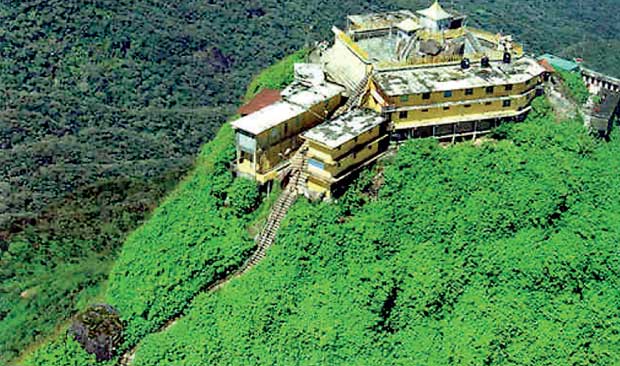A Brief Colonial History Of Ceylon(SriLanka)
Sri Lanka: One Island Two Nations
A Brief Colonial History Of Ceylon(SriLanka)
Sri Lanka: One Island Two Nations
(Full Story)
Search This Blog
Back to 500BC.
==========================
Thiranjala Weerasinghe sj.- One Island Two Nations
?????????????????????????????????????????????????Thursday, July 27, 2017
The story of Mahaweli…

an unending cascade from one generation to another
“The old river in its broad reach rested unruffled at the decline of day, after ages of good service done to the race that peopled its banks, spread out in the tranquil dignity of a waterway leading to the utmost ends of the earth.”
- Joseph Conrad
At the very outset, allow me to draw your attention to an oversight in my previous column on ‘Who represents the real SLFP’. In the 8th paragraph I write thus: “The passage of the 19th Amendment...” It should read as the “18th Amendment”. Please forgive me for this error. Now to my current column:
The mighty Mahaweli River begins its history-laden journey from the zenith of Sri Paada, the pinnacle of Buddhist belief that Siddhartha Gautama, the Buddha laid his footprint, long before Devanampiyatissa ruled Lanka. With this belief held in earnest, many Buddhists - men and women of all walks of life - of all ages, some with hardly any breath left in their lungs but a monumental expanse of faith in their hearts, year in and year out go on pilgrimage to pay homage to the Great Teacher. All main rivers in Sri Lanka; Mahaweli, Kelani, Kalu and Walawé which originate their respective passages from Sri Paada, command the gratitude of an immensely grateful people. Among these rivers Mahaweli is foremost. Its storied expedition through the picturesque hill country into the vast plains of Mahiyangana and Bintenna, carving the ground of an arid and thirsty zone all the way up to the North Central valley and eventually exhausting itself into a resplendent Indian Ocean at Trincomalee, has enriched not only the daily lives of a population but also has ornamented the culture and tradition of an ancient people in Ceylon. With its melodious cascading of water, is brought forth a whisper of arrival of good times.
 In
ancient times, this great river was first diverted, to send its waters
to the North Central province. According to the official records of the
Irrigation Department: ‘Minipe Yoda Ela: the Trans basin canal from
Minipe diversion carried water from Mahaweli Ganga to Amban Ganga. King
Dasankeliya (459 AD) constructed this and it had irrigated in the left
bank of Mahaweli. This gigantic work, which excites the wonder of the
modern engineers, consists of a scheme, which turns the river at a bend
where a large body of water enters the narrow canal formed by an island
contiguous to the bank, partially closed by two rocks, which intercept
the water on its return to the main stream. These rocks, when united by
the masonry, became a dam raising the waters in the natural channel to
great height. Sir Henry Ward in his observations on legend, describes
this canal could have been used for irrigation as well as navigation.
The length of this canal is 50 miles and it merged with Amban Ganga
below Angemedilla anicut. It is important to note that this canal had
followed a trace, which has minimized deep cutting’.
In
ancient times, this great river was first diverted, to send its waters
to the North Central province. According to the official records of the
Irrigation Department: ‘Minipe Yoda Ela: the Trans basin canal from
Minipe diversion carried water from Mahaweli Ganga to Amban Ganga. King
Dasankeliya (459 AD) constructed this and it had irrigated in the left
bank of Mahaweli. This gigantic work, which excites the wonder of the
modern engineers, consists of a scheme, which turns the river at a bend
where a large body of water enters the narrow canal formed by an island
contiguous to the bank, partially closed by two rocks, which intercept
the water on its return to the main stream. These rocks, when united by
the masonry, became a dam raising the waters in the natural channel to
great height. Sir Henry Ward in his observations on legend, describes
this canal could have been used for irrigation as well as navigation.
The length of this canal is 50 miles and it merged with Amban Ganga
below Angemedilla anicut. It is important to note that this canal had
followed a trace, which has minimized deep cutting’.The mighty Mahaweli River begins its history-laden journey from the zenith of Sri Paada, the pinnacle of Buddhist belief that Siddhartha Gautama, the Buddha laid his footprint, long before Devanampiyatissa ruled LankaHistory’s homage apart, the Mahaweli River, despite the various decrees issued by the governors during the British colonial rule to destroy the irrigation structures that had sustained a Sinhala-Buddhist culture for two and half millennia, continued to flow in her usual haste, stirring many a thick foliage and many a hump of sand. Her montage of varied profiles, in times of crisis, has enabled the people of the land to turn to her as a last refuge; whether to water the thirsty land they possessed to cultivate the ever-in-demand rice or for a refreshing bath at the end of the day. They turned to her treasure ever so gratefully.
Ever since the ancient Kings of Lanka, the Mahaweli’s tireless stretch to enrich the land took a brand new turn in the seventh decade of the 20th century. In 1977, the JR Jayewardene govt took a momentous decision.
Without a cent in their coffers to finance the undertaking of diverting the Mahaweli River at more than five locations, constructing six large reservoirs with the capacity to produce hydropower of more than 700 MW and irrigate the water-starved land and settle more than 150,000 families in the downstream zones. Such a transmigration of humanity from one area to another region that was from thick jungle to mild-forests was, under any circumstances, no stress-free task. Galvanizing a bureaucracy from a passive govt service to a vibrant, proactive and forward-thinking force needs foresight, determination, meticulous planning and above all unbending leadership at all levels, from a junior engineer to senior management to Minister and President of the country. During those days, that much of dedication and commitment was forthcoming. A Golden Era of the 20th century had dawned. And it spread its lustre to all corners of the developing regions.
No labour was imported from the countries that donated money for the projects. Meals, basic rice and curry, that were prepared and sold to those local labour forces were the responsibility of the locals.
All subcontractors were locals; those who were engaged in planning, designing, constructing and monitoring, barring some handful of senior staff that belonged to the companies that won the main contracts from the donating countries, were all local. The story of Mahaweli was one hundred percent local. Amazing!
In 1977, the JR govt took a momentous decision. Without a cent in their coffers to finance the undertaking of diverting the Mahaweli River at more than five locations, constructing six large reservoirs with the capacity to produce hydropower of more than 700 MWFrom the time JR decided to launch an accelerated programme to develop and complete a 30-year programme in merely six years, the tensions were many and even disagreements much more among a dedicated and determined work force from Chairman to junior engineers, yet the grit and single-mindedness of Gamini Dissanayake, the young (35-year young?) Minister of Mahaweli Development and Lands and Land Development, pursued the programme to successful completion.
A disturbing pattern of incoherent thinking that was the order of the day during the previous regime of ’70 to’77 was transformed into a logical and balanced pursuit of realistic engineering targets and community-progressive goals. The resurgence of a rustic culture and reawakening of rural inhabitants in the remote corners in the land was visible to any visitor, more to the locals in Colombo and urban habitats than to those who came from beyond our shores. The pulse of a 1000 plus-year of history was being accentuated to a different harmony and it was felt all over the program whose vast implications were at times unfathomable even to a discriminating intellect.
Without the hydropower of the Mahaweli Programme, our country would have crossed the threshold of the twenty first century in darkness. Countermanding a treacherous weather and gracing the soil that cultivates the staple grain that feeds millions of the population with her magnificent presence, the Mahaweli is cascading through an unkind terrain and unforgiving landscape. Order was brought to her unruly surge. Man-made dams and anicuts were constructed in order to store up the abundance of her gush in mighty tanks and reservoirs and served to release the waters. Along her joyous journey emerged new townships and settlement villages with the attendant social infrastructure such as schools, banks, hospitals, post offices and community centres. A novelty of these habitats may have been outlived by the neglect of the present-day bureaucracy. Townships such as Galnewa, Bulnewa, Thambuttegama, Nochchiyagama. Dehiattakandiya, Welikanda and Girandurukotte were not heard of before the Mahaweli Programme was inaugurated. Now they are bustling commercial centres, serving a community whose day-to-day living is made easier by the flow of the Mahaweli. Bursting asunder of traditional irregularities, burying of conventional hostilities and embracing new realities of abundance and plenty, the Mahaweli will glide along, revealing concealed treasures and bringing forth joy and smile to many a profile. Many a damsel silhouetted on the banks of the Mahaweli, with the setting of the sun and with the initiation of twilight will ponder her future; she will be sinking into the joyous dream of her amour. Before her eyes is the eternal flow of the river that has been rendering service to a nation that is more often ungrateful than otherwise. But it shall glide along for the waters not only are the saga of how a nation could be fed and nourished. It is a beautiful story of a civilization.
Townships such as Galnewa, Bulnewa, Thambuttegama, Nochchiyagama. Dehiattakandiya, Welikanda and Girandurukotte were not heard of before the Mahaweli Programme was inauguratedThe river has served the soil of the land. She lies at the roots of a proud nation whose granaries fed not only the locals but, according to the Great Chronicle, the Mahawansa, enabled rice to be exported to neighbouring countries in the glory days. A flow of nourishing water, in addition to helping an already-progressing population towards greater heights, also sprinkled a land with a misty environ in the parched zones, making a sleeping vegetation wake up and blossoming and nourishing a civilization. A stupendous gallery of architectural wonders emerged whose profound magnificence is still bewildering modern scholars. Along its course were erected historic structures, depicting a graceful life of a civilization. Mahaweli represents not only a giant irrigation scheme; it’s not a mere human settlement endeavour; it is not a long and winding stream. It is indeed a civilization.
Sorrow and joy, shall this river endure, and glide its way to eternity!
The writer can be contacted at vishwamithra1984@gmail.com

